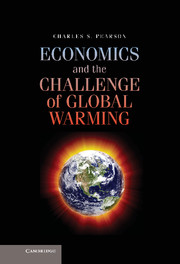Book contents
- Frontmatter
- Contents
- Acknowledgments
- Introduction and a Road Map
- 1 Climate Change
- 2 The Role of Benefit Cost in Climate Policy
- 3 Discounting and Social Weighting (Aggregating over Time and Space)
- 4 Empirical Estimates
- 5 Strategic Responses
- 6 Targets and Tools
- 7 Trade and Global Warming
- 8 The Challenge of International Cooperation
- 9 Beyond Kyoto
- 10 A Summing-Up
- Index
- References
2 - The Role of Benefit Cost in Climate Policy
Published online by Cambridge University Press: 05 June 2012
- Frontmatter
- Contents
- Acknowledgments
- Introduction and a Road Map
- 1 Climate Change
- 2 The Role of Benefit Cost in Climate Policy
- 3 Discounting and Social Weighting (Aggregating over Time and Space)
- 4 Empirical Estimates
- 5 Strategic Responses
- 6 Targets and Tools
- 7 Trade and Global Warming
- 8 The Challenge of International Cooperation
- 9 Beyond Kyoto
- 10 A Summing-Up
- Index
- References
Summary
Benefit-cost (BC) analysis comes in two flavors. The standard, “vanilla” flavor examines the monetized costs and benefits of a project or policy. If the benefits exceed the costs, the project is cleared to proceed. This approach, however, is best suited for projects for which there is only one feasible scale or level of intensity. More frequently, there is a choice of scale, and the objective is to maximize net benefits. This more exotic flavor implies two analytical steps – to calculate the scale or intensity where marginal (incremental) benefits equal marginal (incremental) costs, and then to check that at this scale, benefits exceed costs.
Benefit-cost analysis of global warming policy is done using both approaches. Some studies select a target in terms of greenhouse gas emission levels, atmospheric concentrations, or temperature change, and calculate the costs and benefits of attaining the target. In contrast, some studies attempt to calculate the level of emissions such that marginal abatement costs equal marginal benefits, and social welfare is maximized. This latter approach is more difficult as it requires knowledge of costs and benefits over a range of abatement levels. Whichever approach is taken, the least-cost, or most cost- effective, available abatement measures should be examined and selected. And whichever approach is used, costs and benefits should be converted to the same time period, implying discounting.
- Type
- Chapter
- Information
- Economics and the Challenge of Global Warming , pp. 19 - 42Publisher: Cambridge University PressPrint publication year: 2011



